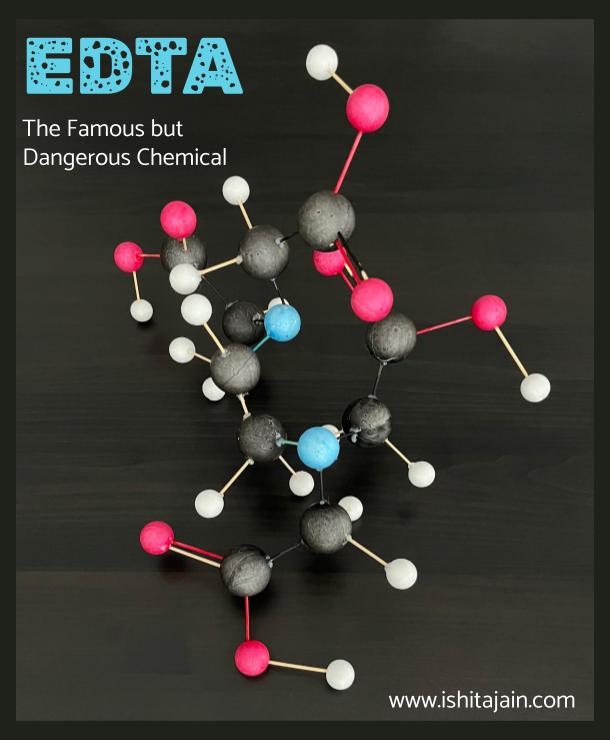This is a 3D model that I constructed of the EDTA molecule using styrofoam balls and toothpicks! The black represents carbon, the blue is nitrogen, the red is oxygen and the white is hydrogen.
The European Union produces 50,000 tons of EDTA annually. The chemical has a variety of commercial and industrial uses, but it also poses a threat to human health and the environment through its manufacturing and administration.
EDTA is an odorless substance with a melting point of 240°C that can appear as either clear crystals or as a white crystalline powder. It is soluble in water but not in organic solvents, and it remains stable when in a solid state or dissolved in an aqueous solution. Its chemical stability can only be disrupted by strong oxidizing agents like peroxides, nitrates or chlorates, substances that have a high electronegativity and tend to gain electrons. EDTA is classified as a weak acid, having a pH of around 5.3 when dissolved in water, and it has a half life of twenty minutes to one hour.
The chemical is well known as a chelating agent, a substance that easily bonds with metal ions. It is able to do this thanks to its complex structure, having a molecular formula of C10H6N2O8. The number of oxygen atoms is vital in its ability to bond with other metal ions. Since metal ions have been linked to producing inflammatory agents that impact the nervous system, a form of EDTA called Calcium Disodium Edetate can help manage neurodegenerative disorders by latching on to those metals. However, it can also result in a zinc deficiency. On the other hand, another form of EDTA, Edetate Disodium, can be used to reduce the risk of Hypercalcemia in cancer patients, which is when there is a rapid and uncontrollable growth of calcium in the blood. Since Edetate Disodium is not absorbed by the gastrointestinal tract, it can bond with the calcium ions and form stable calcium compounds that can easily be flushed out of the body via the kidneys. However, its use in chelation therapy has been limited in recent years since it can result in the patient developing Hypocalcemia, which is too little calcium. In general, EDTA can be used as an anticoagulant, treating blood clots in the heart, and atherosclerosis, the buildup of plaque in artery walls. It is also an FDA-approved method of diagnosing and treating lead poisoning. When injected into the body, EDTA stays within the plasma part of the blood and is transported through the extracellular fluid compartment. Additionally, EDTA serves as an antioxidant, protecting cells from free radicals, easily reactive oxygen atoms that carry an uneven number of electrons. These treatments are important especially for children since they suffer the most from heavy metal toxicity.
However, there are several more health impacts associated with the usage of EDTA. If administered incorrectly, EDTA can cause seizures and cardiac arrest. Another study conducted on mice provided evidence that doses of EDTA that were supposedly safe hold carcinogenic properties and can exacerbate inflammation in the intestines. The chemical is generally classified as an irritant under WHMIS, and physical contact can result in eczema and allergic conjunctivitis, the inflammation of tissue beneath the eyelids. Recurring exposure to the substance can also result in kidney damage.
The manufacturing of EDTA uses many chemicals that are toxic to the environment such as hydrochloric acid and monochloroacetate. The industrial production typically uses formaldehyde and an alkali metal added to an aqueous solution of EDTA, and it releases a byproduct of ammonia. Ammonia can cause eutrophication and increase acid deposition in the soil and bodies of water.
EDTA has many commercial and industrial uses other than as a therapeutic chelating agent. It is used in detergents, water treatment, metal cleansing, photography, cosmetics, and printing ink. It is also used in textile manufacturing and to reverse the impacts of metal ions on bleaching in the pulp and paper industry. Its widespread usage means that it has a lot of exposure to the environment. In fact, there have been trace amounts recorded in our supply of drinking water. Even though EDTA does not meet the criteria to be identified as an environmental hazard by CEPA, the Canadian Environmental Protection Act, the fact that it is available in such large amounts is still dangerous. EDTA is not biodegradable and a lot of the time it ends up chemicalizing natural water and disrupting its metallic balance. Lastly, when heated to around 240°C to 255°C, it will release toxic fumes of nitrogen and sodium oxides.
The amount of reliance on EDTA in our world today makes it almost impossible to completely eradicate. Although it can be useful in some areas, there is a great risk to using too much and handling it improperly. Thus, it is vital that the usage of EDTA be limited, and that alternatives that are safer in general and to manufacture are used whenever possible. Society takes a long time to adapt to social and economic changes, and while it is hard to transition completely out of EDTA, with widespread information about the issue, the usage of the chemical can be reduced to the point of a more environmentally stable world.


